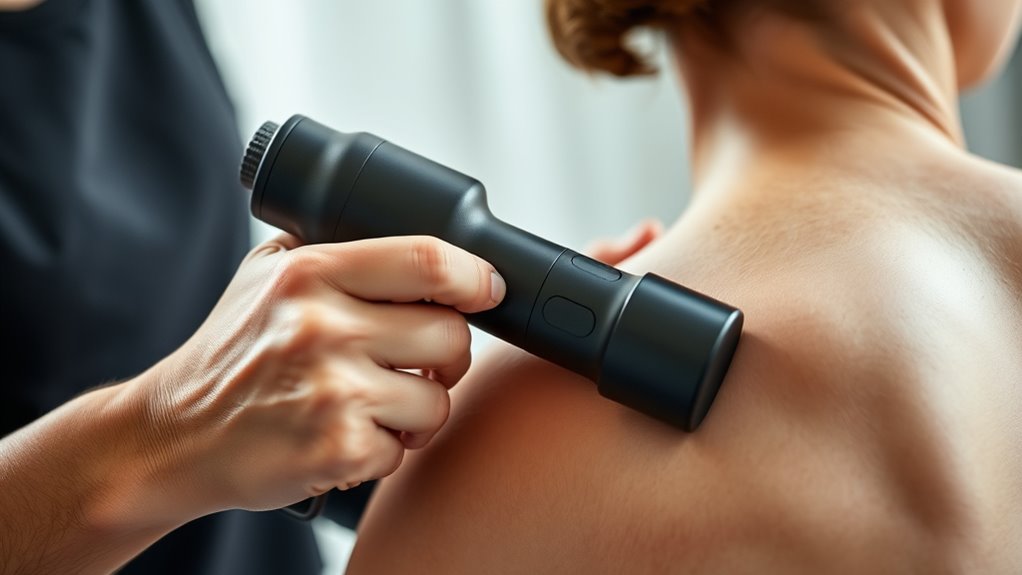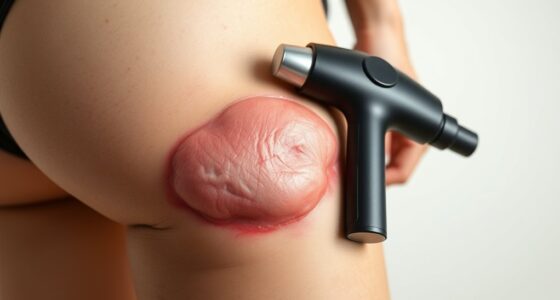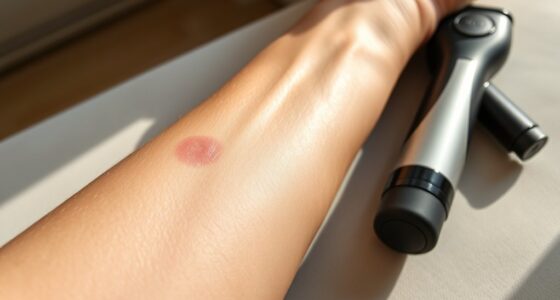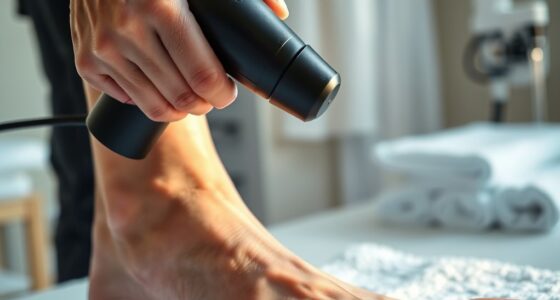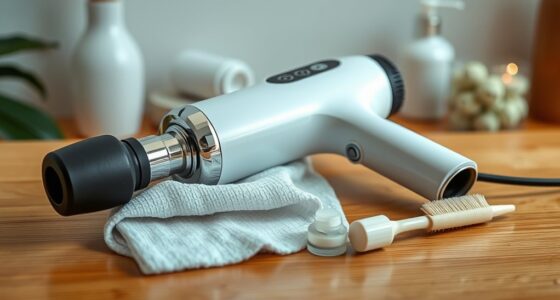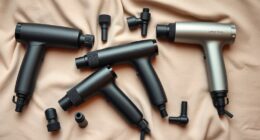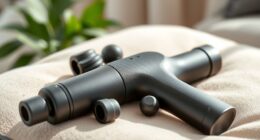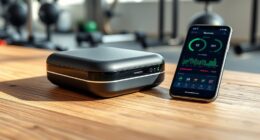To effectively use a massage gun for shoulder pain, start by warming up with gentle stretches and applying a warm compress. Use a low or medium setting, move slowly, and avoid bones or joints. Focus on muscles like the trapezius, deltoids, and rotator cuff, applying gentle pressure and targeting trigger points. Consistency and proper technique are key—continue exploring these tips to discover how to relieve tension safely and effectively.
Key Takeaways
- Use gentle, slow movements with appropriate attachments on low or medium intensity to target shoulder muscles safely.
- Focus on trigger points and knots, applying circular or kneading motions while avoiding bones and joints.
- Warm up the shoulder with gentle stretches and a warm compress before using the massage gun.
- Maintain proper posture during and after treatment to prevent strain and enhance muscle relaxation.
- Follow up with stretching, hydration, and heat therapy to support recovery and prolong relief.
Understanding Shoulder Anatomy and Common Pain Points
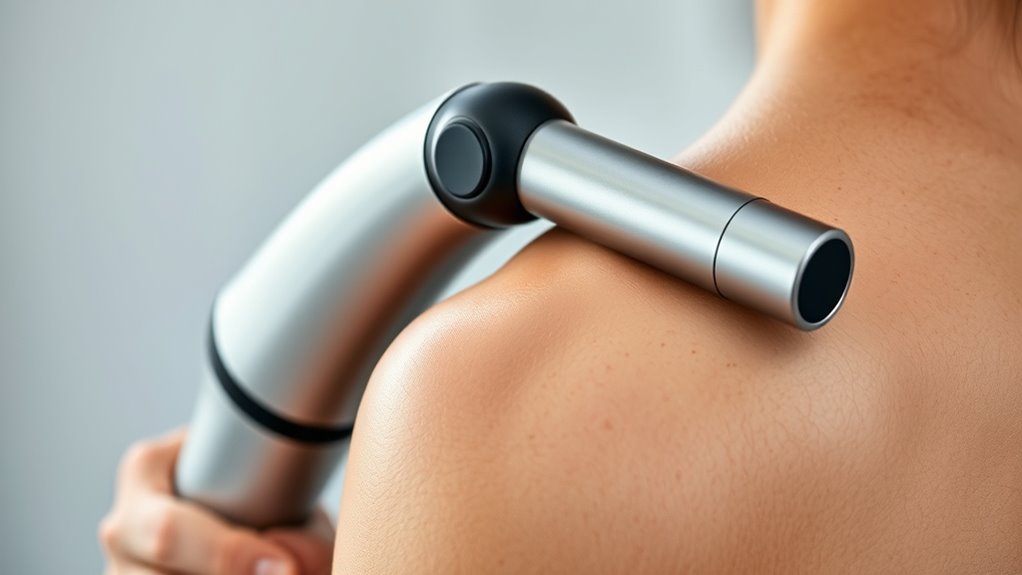
Understanding shoulder anatomy is essential to addressing shoulder pain effectively. Your shoulder is a complex joint involving bones, muscles, tendons, and bursae that work together for smooth movement. The rotator cuff, a group of four muscles and tendons, stabilizes the shoulder and allows you to lift and rotate your arm. When the rotator cuff becomes inflamed or torn, it causes pain and weakness. Shoulder bursitis occurs when the bursae, small fluid-filled sacs cushioning the joint, become inflamed, leading to discomfort and restricted movement. Recognizing these common pain points helps you target treatments accurately. Knowing the anatomy also guides you in applying massage gun therapy safely, avoiding aggravating sensitive areas while promoting healing in the affected tissues.
Preparing Your Shoulder for Massage Gun Therapy

Before using a massage gun, you should warm up your shoulder with gentle stretching exercises to loosen tight muscles. Applying a warm compress can also increase blood flow and prepare the area for deeper therapy. Additionally, maintaining proper posture helps guarantee you’re targeting the right muscles and avoiding unnecessary strain. Incorporating air quality improvement techniques can help create a more comfortable environment for recovery and relaxation.
Gentle Stretching Exercises
Gentle stretching exercises can help prepare your shoulder for massage gun therapy by increasing blood flow and loosening tight muscles. These movements improve joint mobility and activate nerve pathways, making your shoulder more responsive. Focus on slow, controlled stretches to avoid overstretching. For example, arm circles loosen shoulder joints, while cross-body stretches target tight muscles. Incorporate the following exercises:
| Exercise | Benefits | Tips |
|---|---|---|
| Arm Circles | Enhance joint mobility | Keep movements gentle |
| Cross-Body Stretch | Loosen shoulder muscles | Hold for 15-20 seconds |
| Pendulum Swings | Stimulate nerve pathways | Use light momentum |
These exercises prepare your shoulder for effective massage gun treatment and reduce discomfort. Additionally, understanding muscle tension can help you target specific areas more effectively during your therapy.
Warm Compress Application
Applying a warm compress to your shoulder can effectively increase blood flow and relax tight muscles, making massage gun therapy more comfortable and effective. A hot compress helps loosen fascia and reduces stiffness before your session. To prepare, try applying a warm cloth or heating pad for 10-15 minutes. This primes your muscles for better response during treatment. Remember, alternating between hot compress and cold therapy can also reduce inflammation and soothe soreness. Here are some tips:
- Use a hot compress for muscle relaxation before massage
- Limit heat application to 15 minutes to avoid burns
- Combine with cold therapy if swelling occurs
- Always test the temperature before applying to prevent burns
Proper warm-up guarantees your shoulder is ready to benefit fully from massage gun therapy. Incorporating lifestyle habits such as regular stretching and ergonomic adjustments can also support long-term shoulder health.
Proper Posture Alignment
Proper posture alignment is essential to maximize the benefits of massage gun therapy on your shoulder. When you sit or stand with ergonomic furniture that supports good alignment, you reduce unnecessary strain and improve shoulder mobility. Keep your shoulders relaxed and back, avoiding slouching or hunching forward. Proper posture ensures your muscles are in an ideal position for effective massage and helps prevent further discomfort. Before using the massage gun, take a moment to adjust your seating or standing position, aligning your spine and shoulders. This preparation allows the therapy to target tight or sore muscles more precisely. Maintaining good posture not only enhances massage results but also promotes long-term shoulder health and mobility. Recognizing the significance of body alignment can further optimize your therapy sessions and support overall musculoskeletal well-being.
Proper Technique for Using a Massage Gun on the Shoulder
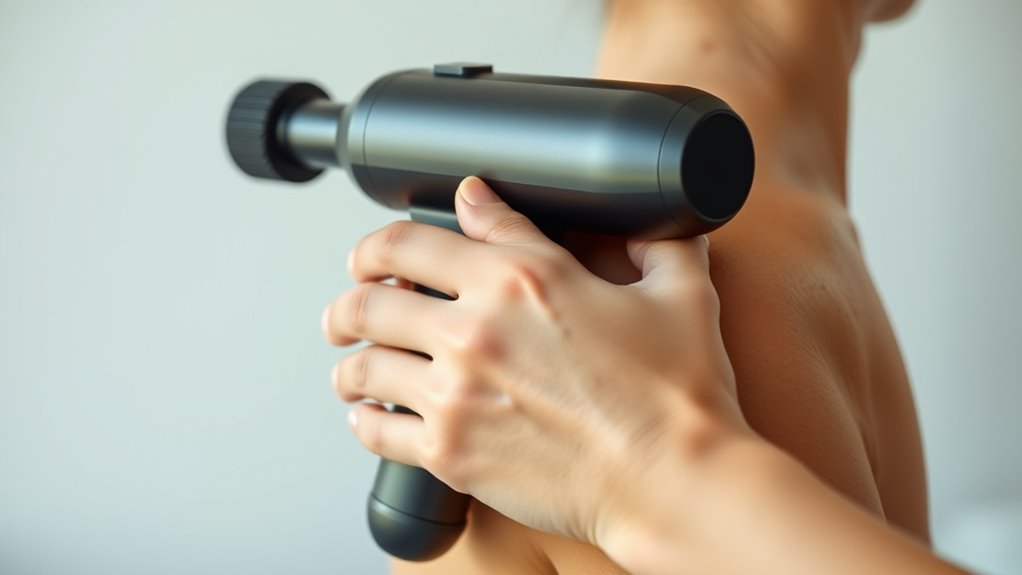
To effectively use a massage gun on your shoulder, start by selecting the appropriate attachment and setting a low to medium intensity. Begin with gentle pressure, and move slowly over the area. Focus on known trigger points, applying the massage gun directly to release tension. Use slow, circular motions to promote fascia release and improve mobility. Keep the device moving to avoid overstimulation or discomfort. Remember to avoid bony areas and joints. Regularly check in with your body to prevent irritation. For best results, target muscles around the shoulder blade and collarbone area. Be patient and consistent, listening to your body’s signals. Proper technique helps maximize benefits and reduces the risk of soreness or injury. Incorporating Proper technique ensures safe and effective use of the massage gun.
Targeting the Trapezius and Upper Back Muscles
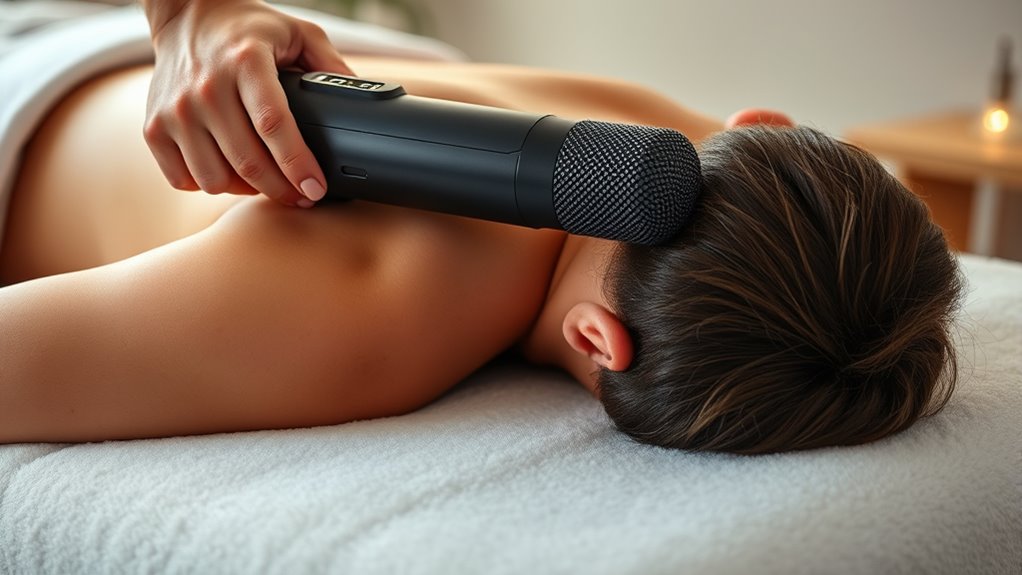
Focusing the massage gun on your trapezius and upper back muscles can effectively relieve tension and reduce discomfort. Targeting trigger points in these areas helps break up knots and relax tight muscles. Use your device with controlled pressure, moving slowly over the muscle fibers to encourage fascia release. Applying the massage gun directly to trigger points can loosen stubborn knots and improve blood flow. Be mindful of tender spots—spend extra time gently kneading them to release built-up tension. Consistent, targeted use enhances muscle relaxation and reduces pain. Remember to keep movements steady and avoid excessive pressure to prevent soreness. Incorporating these techniques into your routine can help you manage shoulder discomfort more effectively, especially in the trapezius and upper back regions. Effective wall organization can also support a relaxing environment, complementing your self-care practices.
Relieving Tension in the Rotator Cuff Area
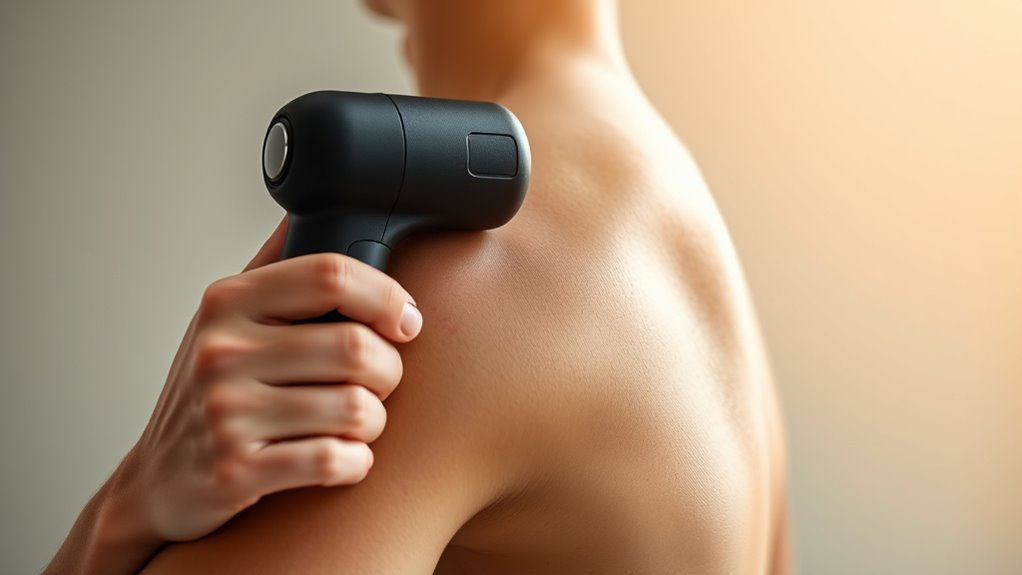
Focusing on targeted muscle relaxation can help alleviate tension in your rotator cuff. Using proper technique and applying the right amount of pressure guarantees effective relief. Regular use of a massage gun can enhance these benefits and support long-term shoulder health. Additionally, incorporating AI-driven revolutionary therapies may further optimize recovery outcomes.
Targeted Muscle Relaxation
Targeted muscle relaxation with a massage gun can effectively ease tension in the rotator cuff area, which often becomes tight and sore due to repetitive movements or injury. By focusing on specific spots, you can release trigger points and loosen stubborn muscle knots that contribute to pain. Use the massage gun to apply gentle, controlled pressure directly where you feel tightness or discomfort. This targeted approach helps improve blood flow, reduce inflammation, and restore muscle flexibility. Remember to stay mindful of your body’s response and avoid overdoing it. Incorporate these strategies:
- Focus on tender spots and trigger points
- Use slow, deliberate strokes for precision
- Adjust pressure as needed for comfort
- Target the muscles around the shoulder blade and collarbone
- Recognize that muscle health is crucial for maintaining shoulder mobility and reducing pain.
This method helps relieve tension precisely where it’s needed most.
Technique and Pressure Tips
To effectively relieve tension in the rotator cuff with a massage gun, proper technique and pressure application are key. You want to target trigger points without overdoing it, which could cause soreness. Use gentle, controlled movements around the shoulder and focus on fascia release to loosen tight tissue. When applying pressure, start light and gradually increase as tolerated. Avoid pressing directly on bones or joints. Always listen to your body, stopping if you feel discomfort. Use the massage gun perpendicular to muscle fibers for ideal results. Here’s a helpful guide:
| Technique | Pressure Tips |
|---|---|
| Target trigger points | Use moderate pressure, avoid pain |
| Focus on fascia release | Light, consistent contact |
| Move slowly along muscles | Increase pressure gradually |
| Avoid bony areas | Gentle, avoid joint pressure |
| Maintain steady, controlled moves | Stop if discomfort occurs |
Additionally, being aware of retail hours can help plan your post-massage errands efficiently.
Benefits of Regular Use
Regular use of a massage gun can considerably reduce shoulder tension and improve mobility in the rotator cuff area. Consistent treatment helps break down trigger points and muscle knots that cause discomfort and limit movement. By targeting these tight spots, you can experience faster recovery from strain and prevent future pain. Regular massage gun use also promotes blood flow, which aids in healing and relaxes stiff muscles. Recognizing these signs can help you determine when your muscles need targeted relief. Incorporating regular sessions into your routine helps keep your shoulders loose, pain-free, and more resilient, making daily activities and workouts more comfortable.
Addressing Deltoid and Surrounding Muscle Groups
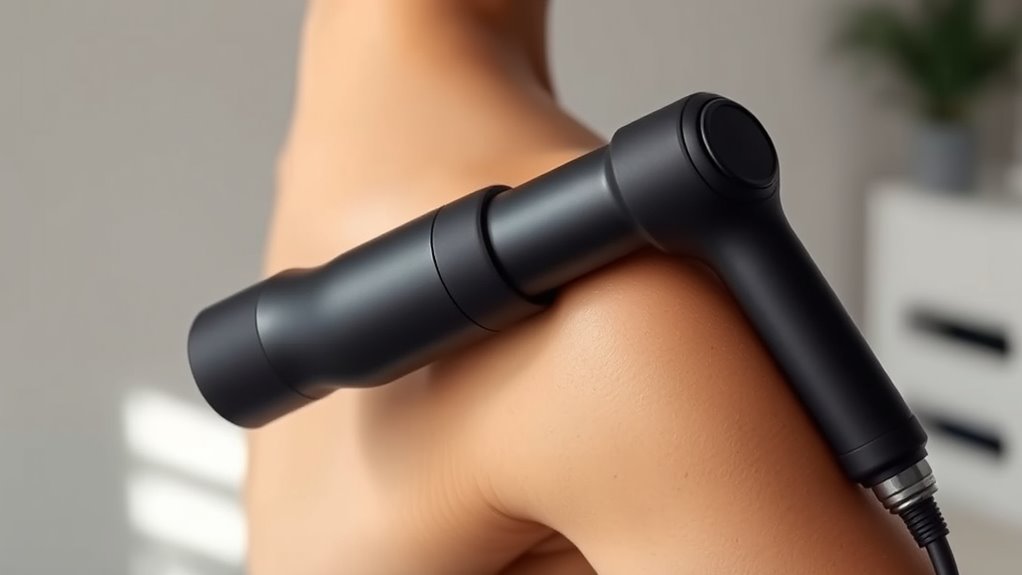
Since the deltoid and surrounding muscles play a key role in shoulder movement and stability, using a massage gun can effectively relieve tension and reduce pain in these areas. Targeting these muscles helps improve mobility, especially if you engage in calisthenics training or rely on nutritional supplements for recovery. Focus on the anterior, lateral, and posterior deltoids, along with surrounding muscles like the rotator cuff. Use gentle, slow strokes to avoid overstimulation. To deepen your understanding, here’s a quick comparison:
| Muscle Group | Function |
|---|---|
| Anterior Deltoid | Flexes and medially rotates the shoulder |
| Lateral Deltoid | Abducts the arm |
| Posterior Deltoid | Extends and laterally rotates the shoulder |
| Surrounding Muscles | Stabilize and support shoulder movement |
Regular massage can complement your calisthenics and nutritional efforts, reducing stiffness and enhancing recovery. Incorporating targeted massage techniques into your routine can optimize muscle recovery and support overall shoulder health.
Tips for Safe and Effective Massage Gun Usage
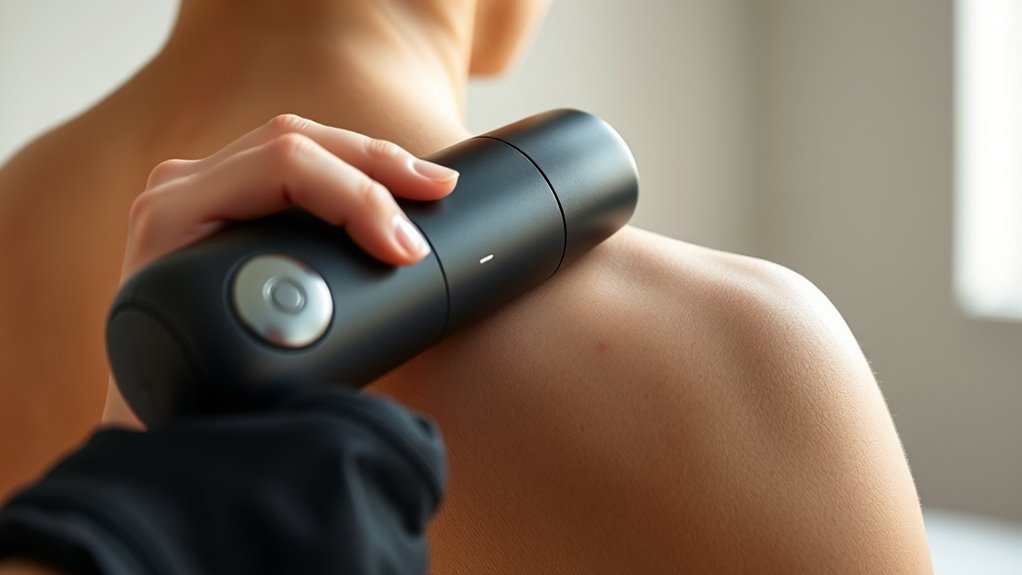
Using a massage gun effectively and safely requires understanding how to target muscles without causing discomfort or injury. Focus on identifying trigger points and areas of muscle tension, applying gentle pressure and listening to your body. Avoid pressing directly on bones or joints to prevent strain. Keep sessions short—about 1-2 minutes per area—and use smooth, overlapping movements. Adjust the speed and intensity based on your comfort level. If you experience pain beyond mild discomfort, stop immediately. Consistently hydrate afterward to help flush out toxins. Remember, moderation is key to prevent overuse or bruising. Incorporate these tips to maximize relief and avoid setbacks, ensuring each session promotes relaxation and muscle recovery safely.
Incorporating Stretches and Exercises Post-Treatment
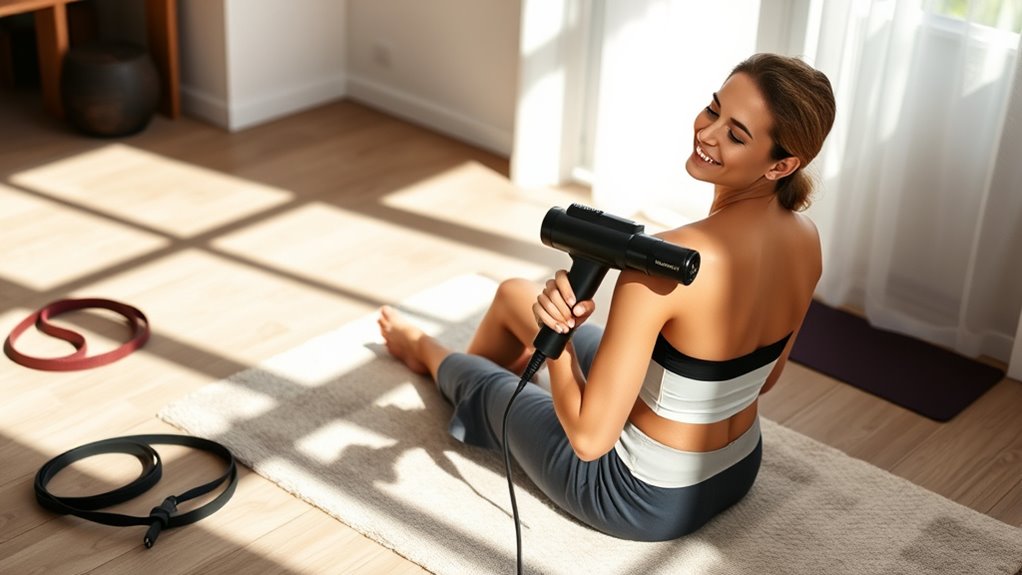
After using a massage gun on your shoulders, incorporating targeted stretches and exercises can enhance muscle flexibility and prevent stiffness. Foam rolling is an effective way to further release muscle tension and improve blood flow. Focus on gentle shoulder rolls and arm stretches to maintain mobility. Heat therapy, like a warm towel or heating pad, can soothe muscles after treatment and prepare them for stretching. Combining these practices helps reduce soreness and supports long-term shoulder health. Remember to stretch slowly and avoid overstretching to prevent injury. Incorporating these techniques into your routine promotes relaxation, increases flexibility, and maximizes the benefits of your massage gun session. Consistency is key to maintaining shoulder comfort and preventing future pain. Using automated cleaning features can help maintain hygiene and keep your treatment area fresh after exercises.
When to Seek Professional Advice for Shoulder Pain

If shoulder pain persists despite using massage guns and other self-care methods, it’s important to recognize when professional advice is needed. Ongoing pain may hinder muscle recovery and reduce the effectiveness of pain management techniques. Seek help if you experience:
- Severe or worsening pain that doesn’t improve with self-care
- Limited shoulder movement or stiffness
- Numbness, tingling, or weakness in your arm
- Pain lasting longer than a few weeks despite massage and stretching
Ignoring these signs can lead to chronic issues or further injury. A healthcare professional can evaluate your condition, recommend targeted treatments, and help develop a thorough pain management plan. Knowing when to consult ensures safer recovery and better shoulder health. Incorporating proper self-care techniques, such as gentle stretching and appropriate usage of massage tools, can also support recovery and reduce discomfort.
Frequently Asked Questions
Can Massage Guns Help With Chronic Shoulder Pain?
You’re wondering if a massage gun can help with chronic shoulder pain. It can be effective by targeting trigger points and promoting tissue relaxation. Using the device on sore areas helps loosen tight muscles and reduce discomfort. Keep in mind, consistency is key, and combining it with stretching or professional treatment enhances results. Always listen to your body, and consult a healthcare provider if pain persists or worsens.
How Often Should I Use a Massage Gun on My Shoulder?
You should follow the frequency guidelines for safe usage and avoid overdoing it. Typically, using a massage gun on your shoulder 2-3 times a day for about 1-2 minutes per area is recommended. Pay attention to your body’s response and reduce usage if you experience discomfort. Always listen to your body and consult a professional if you’re unsure about the appropriate usage duration or frequency.
Are There Any Shoulder Conditions That Contraindicate Massage Gun Use?
You should be cautious if you have a shoulder dislocation or a rotator cuff tear. Using a massage gun on these conditions can worsen the injury or cause additional pain. Always consult your healthcare provider before using a massage gun if you’ve experienced shoulder dislocation or suspect rotator cuff damage. Avoid direct treatment over these areas until you’ve received professional advice to prevent further injury.
What Settings Are Safest for Sensitive Shoulder Areas?
When using a massage gun on sensitive shoulder areas, you should choose lower settings to reduce injury risk. If you have sensitive skin or are prone to discomfort, start with a gentle speed and light pressure. Avoid high-intensity modes until you’re sure your skin and muscles can handle them. Always listen to your body, and stop immediately if you experience pain or irritation to prevent injury.
Can Massage Guns Replace Physical Therapy for Shoulder Injuries?
Imagine a moment where relief seems within reach, but can a massage gun truly replace physical therapy? While massage guns help soothe muscles and reduce tension, their limitations mean they can’t address underlying issues or restore full shoulder function. Physical therapy remains necessary for thorough recovery, tailored exercises, and addressing root causes. So, don’t rely solely on a massage gun—consider it a helpful tool, but not a full substitute for professional care.
Conclusion
Think of your shoulder as a delicate garden—tender yet resilient. Using a massage gun carefully is like tending to your blooms, easing away the weeds of tension to let your muscles flourish. With patience and proper technique, you nurture your body’s harmony and strength. Remember, sometimes the most beautiful growth comes from gentle care. Keep listening to your body, and your shoulder will bloom with health and vigor.
